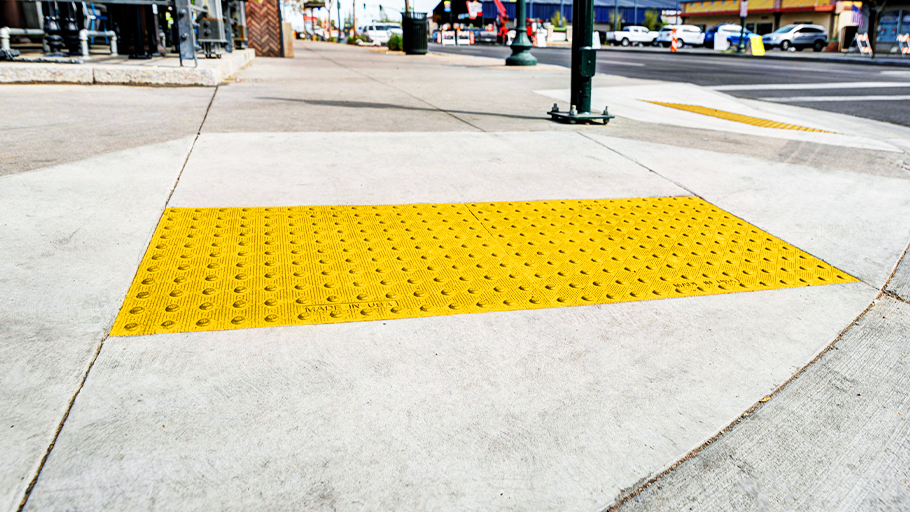Tactile surfaces help keep visually-impaired transit riders safe, but they also help distracted pedestrians navigate busy transit hubs
What are detectable warning plates?
Tactile or detectible warning plates are a system of textured ground surfaces developed to alert visually impaired pedestrians that they may be heading into potentially dangerous terrain, such as the top of a flight of stairs, an escalator, a curb or crosswalk, or the edge of a train platform. Also known as tenji blocks, named after the Japanese braille system, detectable warning plates use a system of raised patterns to warn pedestrians of potential hazards, including curbs and ramps.
Created by Japanese inventor Seiichi Miyake in 1965, tactile paving patterns are a language all their own, with rows, domes and lines conveying different meanings and contexts to vision-impaired pedestrians navigating the urban streetscape. For example, a ‘blister’ surface of rounded raised domes provides a hazard warning, while raised lines offer directional guidance. Tactile paving is often brightly colored to improve visual contrast for people with low or limited vision who may not be using canes. High contrast detectable warning plates also help busy, distracted riders and pedestrians navigate hectic urban environments and transit hubs.

What are the North American regulations around accessible design?
In the United States, detectable warning plates are required in all federally-funded facilities under the Americans with Disabilities Act (ADA). In addition to ADA requirements for federally-funded buildings and facilities, the U.S. Department of Transportation (USDOT) also has a set of regulations regarding the spacing, sizing, and visible contrast of detectable warning plates.
In Canada, each province has specific accessibility laws dealing with tactile warning plates. For example, in Ontario, new or redeveloped pedestrian crossings with curb ramps must include high contrast, raised surface indicators. Most urban renewal and redesign projects require tactile warning systems as part of local government commitment to greater accessibility. Detectable warning plates are a key universal design element, helping to ensure that our urban environments are accessible to all.

Why do we need detectable warning surfaces on public transit?
It’s hard to argue against the usefulness of detectable warning plates in public transit. Tactile warning plates are particularly effective for alerting vision-impaired transit users to the presence of bus stops, platform edges, accessibility ramps, and other risks or obstacles. Truncated surface domes offer both an auditory clue to terrain changes for cane users and a tactile clue that can be felt through shoes.
Tactile warning systems are crucial in maintaining a barrier-free public transit system and promoting the independence of people with low or no vision. Sadly, the lack of detectible warning plates in some transit systems has been linked to tragic fatalities. Installing detectable warning surfaces in new transit builds and retrofitting older transit hubs and stations is a critical step to creating and maintaining a safe, modern transit system for everyone.

In addition to alerting visually impaired riders to potential dangers and hazards, detectable warning plates can also help orient distracted transit users in busy stations, and better define walkways and transit stops for all transit riders. Tactile warning plates help make transit safer for all users by providing directional cues to passengers, especially in areas with poor or dim lighting. Older transit systems can be retrofitted with detectable warning plates and other tactile warning systems to increase safety and accessibility for all users.
Federal ADA standards for transportation facilities in the United States require detectable warning plates on curb ramps, bus boarding areas, and rail station platforms and to highlight accessible routes. Other rules and regulations may vary by state and municipality.

Choosing the best tactile warning plates for public transportation
When choosing tactile ground surface installations for transportation projects, there are many factors to consider. First, you’ll need to know the purpose of your install. There are two broad categories for tactile ground surface indicators: they are either used as directional cues (stripe patterns) or as warning markers (dot patterns). Many public transit hubs require both.
From there, you’ll want to think about material, durability, and installation as well as where your detectable warning plates will be installed. For example, if your tactile ground warning system will be installed outdoors, you’ll want to make sure the system you choose has a low water absorption rate. You’ll also want to consider slip resistance, as surfaces can sometimes present a hazard for transit riders using crutches or mobility devices. Ensure that the tactile ground warning system you choose allows for void-free installation, leaving a safe, solid, gapless surface for passengers to walk on.

Spend some time thinking about how often you’ll need to replace the plates due to deterioration over time. Tactile ground surface systems come in several versatile materials, including plastic, ceramic, concrete, steel, and cast iron. When considering materials, durability will likely be your primary consideration, especially for transit projects, where your detectable warning plates will be walked over countless times a day. Transit systems have been sued by injured riders unable to detect old, worn down tactile warning plates on train platforms, so you need to make sure the material you choose will withstand high volume pedestrian traffic over the long term. For pure, long-lasting wear and tear resistance, you can’t beat cast iron warning plates, which are ideal for bus stops and curbs. Non-skid cast iron warning plates are also perfect for new builds, as they are easily installed in wet concrete.
